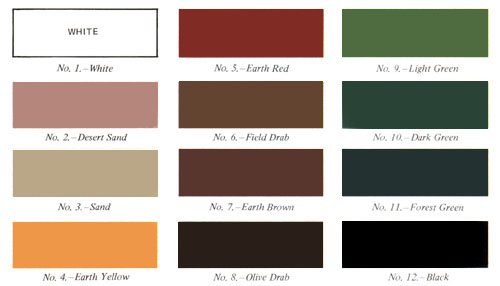
Standard Camouflage Colors
(Note: Colors do not reproduce accurately on computer monitors.)
Camouflage Pattern Painting
This circular describes an improved method of camouflaging military equipment and how to apply it to existing equipment. This improved method is simple, and field tests have proved that it works well in confusing the enemy observer and enhancing battlefield survivability. It consists of painting newly developed patterns on the equipment, using only four colors. The patterns (different for each model of vehicle or item of equipment) have been carefully worked out by a team of camouflage experts and scientists. Unlike older camouflage patterns, this is a general all-purpose pattern. By changing only one of the four colors, or at most, two, the same basic pattern can be made to work equally well in different seasons of the year or on different types of terrain.
The theory behind this new pattern-painting design is to provide a system that can be adapted to various geographical and seasonal changes by the changing of one or, at most, two colors. For instance, the forest green can be changed to sand for desert operations, or the field drab changed to dark green and the sand to field drab for temperate climate terrain in summer. By using the appropriate color from the standard camouflage color chart (below) in conjunction with the pattern-painting design, a good color combination for almost every terrain can be obtained.
These new designs also lend themselves to touchup painting with better results than are now obtainable from touchup of the current OD vehicles. Slight mismatches in color will not be as noticeable as they are on a solid-colored vehicle except from very close inspection. Likewise, minor abrasions and scaling of surfaces will be equally inconspicuous.

Standard Camouflage Colors
(Note: Colors do not reproduce accurately on computer monitors.)
The camouflage pattern consists of wavy, irregular patches of color applied to the vehicle. The colors used for the patterns have been selected from the standard camouflage colors as shown in the chart above.
The patterns use only four of these colors, for any geographic or climatic conditions. The only exception is winter arctic, which is solid white. When changing from one geographic or climatic condition to another, the shape of the pattern itself does not change; only one or two of the colors that make up the pattern change. The next table shows the combinations of colors to be used for various seasons and climatic regions. The first and second colors each cover about 45% of the vehicle; the third color covers 5% of the vehicle; and the fourth color, normally black, covers the remaining 5%. The color numbers 1, 2, and 3 identify the first three colors, and are used in the pattern designs to show what color goes where on the vehicle.
| Condition | Color Distribution | |||
| 1 - 45% (base) | 2 - 45% | 3 - 5% (soil) | 4 - 5% | |
| Winter US & Europe - verdant | Forest Green | Field Drab | Sand | Black |
| Snow - temperate w/trees & shrubs | Forest Green | White | Sand | Black |
| Snow - temperate w/open terrain | White | Field Drab | Sand | Black |
Summer US & Europe - verdant |
Forest Green | Light Green | Sand | Black |
| Tropics - verdant | Forest Green | Dark Green | Light Green | Black |
| Gray desert | Sand | Field Drab | Earth Yellow | Black |
| Red desert | Earth Red | Earth Yellow | Sand | Black |
| Winter Arctic | White | White | White | White |
The color patterns in the above table were designed for world-wide application, and cover a wide range of terrain conditions. It is possible that any given color combination may not be an exact match for some specific local condition. In such a case, the 12 colors available in camouflage paints give the local commander wide latitude to modify the color combination and develop one that more closely matches the local terrain and operating conditions. Note: Individual colors must not be mixed with one another as this will destroy the camouflage characteristics of the paint.
New items of tactical equipment will be painted lusterless forest green at the factory. Since the base paint of forest green is usually one of the large 45% color areas, troops will have to pattern paint only three colors. The actual paint to be added will then be one large 45% area and the two small 5% areas.
Camo patterns: Flat pattern, Trailer 1, Trailer 2
Source: http://www.olive-drab.com/od_mvg_camo_tc5-200.php